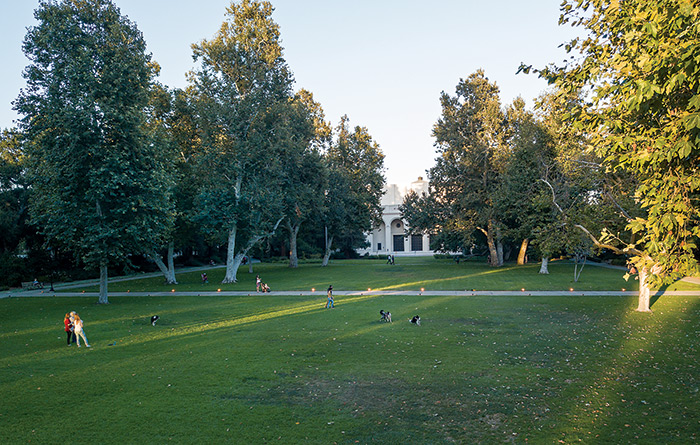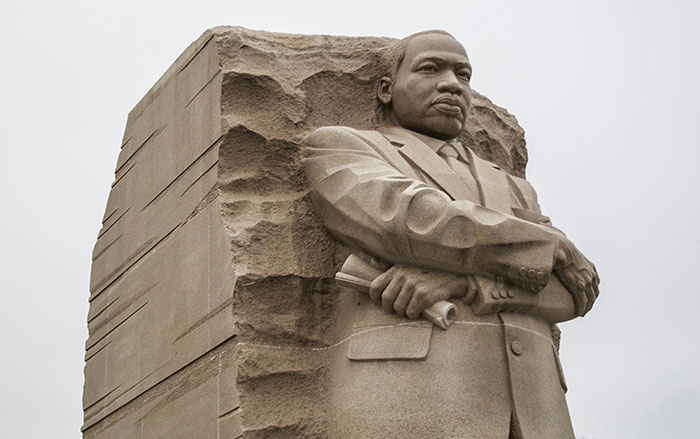New plants and ideas blossom on Marston Quad

Marston Quad in late afternoon shadow, making it a cool location to enjoy a warm waning summer day. Courier photo/Peter Weinberger
By Char Miller | Special to the Courier
The signs are up, though they are low to the ground so you will have to bend down to read them. But make a point of doing so the next time you stroll along the north side of Marston Quad on the Pomona College campus, coffee in hand, dog on leash.
What you will see is a series of plant-identification signs, perhaps unlike any you have encountered. The names of individual plants are listed in three languages, the most prominent of which is Tongva, one of the original languages of this region. Beneath it and in smaller type are the names in Latin and English. Look, then, for Paa’or ‘ahooken (purple sage), Wiit (live oak), and Shooshmat (mulefat); Huunarkwa’a (coffeeberry) and Piinor ‘ahuungin (California fuschia).
The linguistic hierarchy is deliberate, because the campus and surrounding communities, like the coastal and inland valleys to our west and south, are the traditional, ancestral, and unceded territory of the Gabrielino/Tongva people. As a small reversal of the disturbing history of genocidal violence and dispossession that disrupted Tongvan lives and landscapes beginning in the eighteenth century, an Altadena philanthropist in October 2022 returned the first acre of land to Tongvan sovereignty in more than two centuries.
Of course, no trilingual markers can compensate for this brutal past, but their presence can remind those of us who are nonindigenous of the catastrophe that occurred when successive waves of Spanish, Mexican, and American invaders dominated the region.
These signs also demonstrate the college’s concerted effort to shift the palette of plants — and the ideas they represent — that hitherto has framed Marston Quad. Originally laid out to invoke Thomas Jefferson’s design of the University of Virginia, the quad has been central to Pomona’s ambition to link its academic aspirations to a classical tradition: Roman and Greek by way of the Old Dominion. Look East, young college.
Pomona’s eastward gaze is also revealed in its clearing away the endemic vegetation (coastal sage and chaparral) that it replaced with irrigated sweeps of green grass and stands of eucalypts, cedars, and redwoods. Legend has it that at some point Marston Quad contained specimens of every (thirsty) plant mentioned in Shakespeare’s oeuvre. Thirstier still were the tropical species — banana trees, citrus, and palms — gracing courtyards and lining walkways.
There is irony embedded in these choices, some of which were the brainchild of the college’s longtime landscape architect, Ralph Cornell. In 1913, while an undergraduate at Pomona, he had published an important article praising Southern California’s native plants and arguing for their protection and proliferation. “What could be more interesting and educational,” he wrote, “than a public park devoted to plants indigenous to our dry and semi-arid lands, and representative of the many forms of plant life that are found along our coast slopes? A dry ground park, planted only to native trees, shrubs and flowers, would be one of the greatest possible assets to Southern California.” He never applied this logic to his alma mater’s campus.
A century later, a group of student activists resuscitated Cornell’s initial insights, and in collaboration with the college’s grounds department, began to plant sages and manzanita. The January 2022 windstorm, which toppled many oaks that had shaded Stover Memorial Walkway and Marston Quad’s promenades, was the impetus for the current initiative. After reading a post-storm senior capstone project that urged the college to re-indigenize the quad, and in partnership with Tina Calderon, a culture bearer of Gabrielino Tongva, Chumash and Yoeme descent, landscape architect Ben McCoy designed the new markers and the array of native plants they identify.
One sign of Marston Quad’s increasing resilience is that the aromatic Paa’or piinor (hummingbird sage) is already attracting pollinators. Another is the luxuriant growth of Shaamat (California fescue), a bunchgrass whose seeds can be pounded into flour, its durable foliage used as thatch. Hardy and useful, it is also beautiful, swaying feather-like in a gentle breeze.
Char Miller is the W.M. Keck Professor of Environmental Analysis and History at Pomona College, and author of “Natural Consequences: Intimate Essays for a Planet in Peril.”








0 Comments